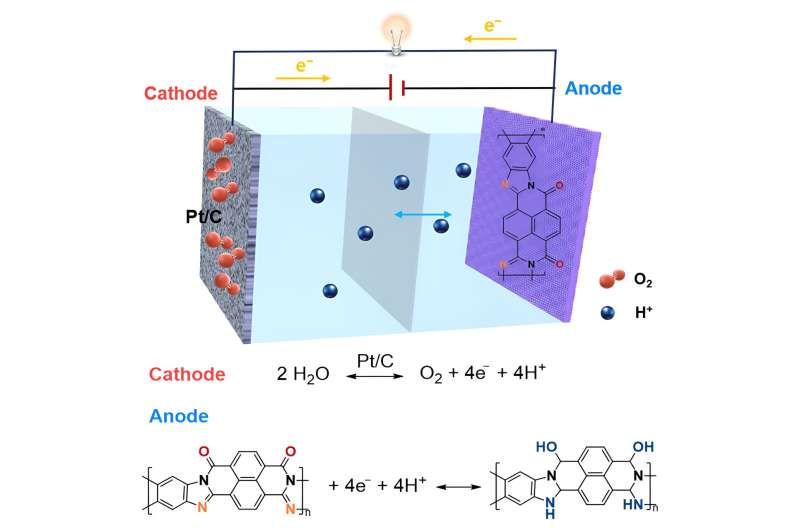This article has been reviewed according to Science X's editorial process and policies. Editors have highlighted the following attributes while ensuring the content's credibility:
fact-checked
peer-reviewed publication
trusted source
proofread
Polymer-air battery research investigates advanced energy storage solutions

Polymer-air batteries often face challenges related to stability, kinetics and conductivity. In response, Dr. Jodie Lutkenhaus has developed a method to use a polymer as an anode in these batteries.
In a recent article published in Joule, Lutkenhaus, associate department head of internal engagement and chemical engineering professor at Texas A&M University, collaborated with chemical engineering professor Dr. Abdoulaye Djire to reveal how these polymers store and exchange charge with the electrolyte.
"The cathode reacts with oxygen from air to complete the circuit. We specifically targeted the use of a conjugated polymer with a rigid backbone structure for the anode," Lutkenhaus said.
These features make the polymer both conductive and stable, enabling the necessary reversible reactions required for repeated charging and discharging, she said.
Despite the benefits of aqueous polymer-air batteries, including improved safety, reduced cost, higher ionic conductivity and sustainability, their electrochemical performance is limited, the article stated.
"To overcome these limitations, researchers have explored alternative polymer anodes, which have several advantages over metal anodes, including low cost, ease of functionalization and high stability," the researchers write.
The battery's rigid ladder structure, fast kinetics and high electrical conductivity allowed it to undergo 500 cycles with minimal performance loss. Additionally, the article revealed the real-time charge transfer mechanism, demonstrating a fast hydronium ion charge compensation process.
The article notes that metal-air batteries have a higher energy density compared to conventional lithium-ion batteries. This is attributed to the oxygen cathode, which offers a much higher capacity than conventional metal oxide cathodes. However, the article highlights limitations in using metal anodes in air batteries due to the stability, cost, and environmental impact of extracting and processing metal resources.
Issues like dendrites, passivation and corrosion on the metal anode lead to low utilization and inferior cycling stability in metal-air batteries. Despite the adoption of interfacial modification and electrolyte formulation, these issues can be severe in the presence of oxygen from the air.
"The polymer-air battery provides an alternative means of storing energy versus the metal-air battery," Lutkenhaus said. "The polymer-air battery has a high capacity for energy storage and a very long cycle life."
She explained that having a long cycle life means that people can use their batteries longer before having to recharge them or replace them.
"Air-based batteries are promising for high-energy batteries because they have a lower mass than conventional batteries," Lutkenhaus said. "However, long-term operation of air-based batteries often results in the generation of carbonate deposits that clog the battery and prevent long-term operation. By using a polymer as an electrode, we could change the electrolyte to prevent the formation of carbonates."
More information: Ting Ma et al, Understanding the mechanism of a conjugated ladder polymer as a stable anode for acidic polymer-air batteries, Joule (2023). DOI: 10.1016/j.joule.2023.08.009



















